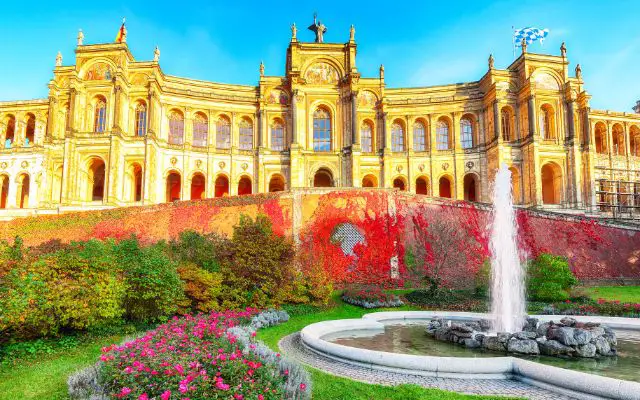If you’re looking for places to visit in Munich that are a little more off the beaten track than the usual tourist fare, then the Maximilianeum Munich is a great choice.
Situated across the Isar River from the city center, this architectural beauty provides a look into Munich’s past, present, and future.
The Bavarian State Parliament, and gifted students from Bavaria all call the Maximilianeum Munich home, and a guided tour through its halls is a highly rated way to elevate your visit to Munich with a peek inside its political and educational culture.
What is the Maximilianeum?
The Maximilianeum is a grand, palatial building that was first constructed under the orders of King Maximilian II of the Wittelsbach family in 1857, to provide housing within the city for gifted students. Although this is not the only reason the Maximilianeum is famous, it also houses the Bavarian State Parliament and has done since 1949.
Where is the Maximilianeum?
The perpendicular gothic masterpiece that is the Maximilianeum sits on Max Planck Strasse as it crosses the Isar River into central Munich.
Despite being a little further south than many of the tourist attractions in Munich, the Maximilianeum is set in a beautiful, much quieter district of the city, and here you’ll never be far away from a swanky bar or hearty tap house.
If you are walking from central Munich to the Maximilianeum, which takes around 20 minutes, on the Maximilianstrasse you’ll also see a few other examples of Palaces in Munich to visit, as this royal avenue is filled with them.
History of the Maximilianeum Munich
King Maximilian II created the Maximilianeum Foundation, or Stiftung, in 1852 to allow gifted students from across Bavaria to study in the capital city, without worry over living costs.
The Maximilianeum was also conceived of by King Max, who was intent on turning Munich into a cultural and educational center.
The original purpose of the Maximilianeum Munich was to house these gifted students who may not have been so lucky without the Stiftung, alongside facilitating the day-to-day running of the foundation.
The Maximilianeum was designed by Freidrich Burklein, architect to the Wittelsbach Family, who dreamt up many a state building in Munich.
The project was then taken over by Gottfried Semper who took the design in a more renaissance direction, giving the Maximilianeum its characteristic columns and arches, complete with mosaics and alcoves filled with marble busts. It was finally completed in 1874, though unfortunately, King Max died before he got the chance to see it completed.
But at the close of the Second World War, the Maximilianeum was not exempt from the destruction suffered in the Bavarian capital.
The foundation was then struck with the issue of rebuilding the Maximilianeum at great cost. They found a perfect partner, however, in the Bavarian State Parliament, which had lost its own building during the war.
The Landtag and Senate both moved into the Maximilianeum, and the symbiosis that brought the foundation and Bavarian parliament together is maintained to this very day.
As a final note, in 1980 Duke Albrecht of Bavaria created the Wittelsbach Jubilee Foundation to offer the same benefits of the foundation to female students for the first time.
Maximilianeum Munich Tours
Upon visiting the Maximilianeum you will get the opportunity to see both the parliamentary rooms, where the day to day running of the state takes place, as well as experience the same halls that were first dreamt up for the Maximilian Foundation and its gifted students.
The Bavarian State Parliament, or Bayerischer Landtag, offers a popular visitors program wherein people from around the world can sit in on plenary sessions and committee meetings, as well as receive a guided tour of the Maximilianeum Munich, and some of the artwork housed inside.
To take advantage of this as an individual or small group you can register online at the German site here.
Alternatively, while you won’t get as in-depth a political and cultural experience, there are many Munich highlights tours that take the trip down the Maximilianstrasse and past the Maximilianeum.
The benefit to these tours is that you’ll get a full rundown of the history of the Maximilianeum, and more of a focus on the stunning architecture.
The Maximilianeum and surrounding streets are particularly beautiful at night when they are illuminated next to the river, so why not try a night tour? Or, as a fun experience for the whole family in Munich, try a Segway tour around the city.
How To Get to The Munich Maximilianeum
Whatever your transport of choice is on your visit to Munich, getting to the Maximilianeum is easy thanks to multiple connections around the attraction.
S-Bahn – If you’d like to catch the train to the Maximilianeum, the closest S-Bahn station is Rosenheimer Platz, a 10 minute walk away from the Bavarian State Parliament. The Rosenheimer Platz station is served by every line on the S-Bahn, so this is a great choice for public transport to the Maximilianeum no matter where in Munich you’re coming from.
U-Bahn – The Max Weber Platz underground station is around a 2 minute walk from the Maximilianeum Munich entrance, though you’ll spot it as soon as you leave the station. Use lines U4, and U5, which both stop here.
Tram – The Maximilianeum tram stop is directly outside the Bavarian State Parliament building, and is served by the tram lines 19, 21, N17, and N19.
Bus – The Maximilianeum can be found on the number 100 line, also known as the museum line as it passes by so many interesting places in Munich. The number 155 bus also stops on Max Weber Paltz, just a short stroll from the Maximilianeum.
Taxi – Finally there is a Taxi stand on Insmaninger Strasse, only a 3 minute walk from the entrance to the Maximilianeum.

